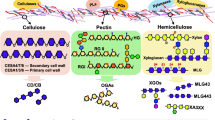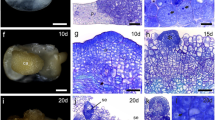Abstract
We have re-examined the evidence against the phloem mobility of oligogalacturonide elicitors using a reduced oligogalacturonide in the phloem translocation system ofRicinus communis var. Gibsonii. A tritium-labelled end-reduced oligogalacturonide of degree of polymerisation 6 was injected into the hollow centre of the petiole of four- to five-week-old plants. Two experimental procedures were followed. In the first, the whole plant was harvested and dissected after 5 h incubation. In the second, phloem sap was collected from an incision in the main stem below the injected petiole; collection started 2 h after incubation and continued for a further 3 h. Determination of the total radiolabel present in the dissected plant showed that at least 8% of the applied activity was exported from the injected leaf, most of this being recovered from the main stem below the injected petiole and the roots. The activity in the phloem exudate showed that the rate of export of radiolabel was already at its maximum by the end of the 2-h incubation period. Radiolabelled material recovered from the main stem was found to be highly comparable to starting material when subjected to thin-layer chromatography. These results demonstrate the phloem mobility of reduced oligogalacturonides of low degree of polymerisation and therefore re-establish the potential for oligogalacturonides to act as systemic signals.
Similar content being viewed by others
Abbreviations
- d.p.:
-
degree of polymerisation
- log Kow :
-
logarithm of ratio of solubilities in octan-1-ol and water
- ROG6:
-
reduced oligogalacturonide d.p.6
References
Baydoun, E.A-H., Fry, S.C. (1985) The immobility of pectic substances in injured tomato leaves and its bearing on the identity of the wound hormone. Planta165, 269–276
Briggs, G.G. (1981) Theoretical and experimental relationships between soil absorption, octanol-water partition coefficients, water solubilities, bioconcentration factors, and the parachor. J. Agric. Food Chem.29, 1050–1059
Bromilow, R.H., Chamberlain, K. (1989) Designing molecules for systemicity. In: Mechanisms and regulation of transport processes, pp. 113–128, Atkin, R.K. Clifford D.R., eds. British Plant Growth Regulator Group, Monograph 18
Bromilow, R.H., Chamberlain, K., Patil, S.G. (1990) A rapid method usingRicinus communis for the estimation of phloem translocation of xenobiotics. Pestic. Sci.30, 1–12
Doherty, H.M. (1989) A study on the role of oligosaccharides in the wound response of tomato plants. Ph.D. thesis, University of Leeds
Djordjevic, S.P., Batley, M., Redmond, J.W. (1986) Preparative gel chromatography of acidic polysaccharides using a volatile buffer. J. Chromatogr.354, 507–510
Farmer, E.E., Ryan, C.A. (1992) Octadenanoid precursors of jasmonic acid activate the synthesis of wound-inducible proteinase inhibitors. Plant Cell4, 129–134
Green, T.R., Ryan, C.A. (1972) Wound induced proteinase inhibitor in plant leaves. A possible defense mechanism against insects. Science175, 776–777
Hammond-Kosack, K.E., Atkinson, H.J., Bowles, D.J. (1989) Systemic accumulation of novel proteins in the apoplast of the leaves of potato plants following root invasion by the cystnematodeGlobodera rostochiensis. Physiol. Mol. Plant Pathol.35, 495–506
Jin, D.F., West, C.A. (1984) Characteristics of galacturonic acid oligomers as elicitors of casbene synthetase activity in castor bean seedlings. Plant Physiol.74, 989–992
MacDougall, A.J., Rigby, N.M., Needs, P.W., Selvendran, R.R. (1992) Movement and metabolism of oligogalacturonide elicitors in tomato shoots. Planta188, 566–574
Malone, M., Stankovic, B. (1991) Surface potential and hydraulic signals in wheat leaves following localized wounding by heat. Plant Cell Environ.14, 431–436
Pearce, G., Strydom, D., Johnson, S., Ryan, C.A. (1991) A polypeptide from tomato leaves induces wound-inducible proteinase inhibitor proteins. Science253, 895–897
Rao-Madamanchi, N., Kuc, J. (1991) Induced systemic resistance in plants. In: The fungal spore and disease initiation in plants and animals, pp. 347–362, Cole, G.T., Hoch, H.C., eds Plenum Press, New York
Selvendran, R.R., Isherwood, F.A. (1967) The identification of guanosine diphosphate derivatives ofd-xylose,d-mannose,d-glucose andd-galactose in mature strawberry leaves. Biochem. J.105, 723–728
Wildon, D.C., Thain, J.F., Minchin, P.E.H., Gubb, I.R., Reilly, A.J., Skipper, Y.D., Doherty, H.M., O'Donnell, P.J., Bowles, D.J. (1992) Electrical signalling and systemic proteinase inhibitor induction in the wounded plant. Nature360, 62–65
Author information
Authors and Affiliations
Rights and permissions
About this article
Cite this article
Rigby, N.M., MacDougall, A.J., Needs, P.W. et al. Phloem translocation of a reduced oligogalacturonide inRicinus communis L. Planta 193, 536–541 (1994). https://doi.org/10.1007/BF02411559
Received:
Accepted:
Issue Date:
DOI: https://doi.org/10.1007/BF02411559




